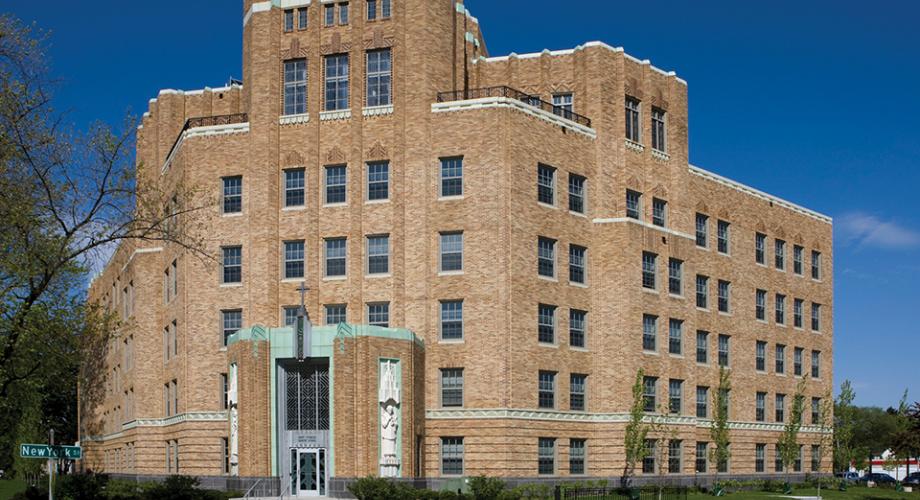For developers, tax credits can be a vital source of funding needed to get projects off the ground.
In suburban Chicago, St. Charles Hospital, a 1932 Art Deco-style building designed by Wybe J. Van der Meer, stood vacant for nearly five years despite being listed on the National Register of Historic Places. Thanks to a $24 million redevelopment effort spearheaded by Evergreen Real Estate Group in 2015, the deteriorating building was transformed into Aurora St. Charles Senior Living, a 60-unit independent living facility that provides affordable housing for low-income seniors.
It’s a project that wouldn’t have been possible without Evergreen’s extensive knowledge of tax credits and alternative forms of financing. While a variety of options are available for adaptive reuse projects like the Aurora redevelopment, including federal historic preservation and low-income housing tax credits, it was the River Edge Redevelopment Zone (RERZ) program – a state-level program that incentivizes riverfront preservation projects in five Illinois cities – that allowed the developer to move forward with the project.
“Aurora was one of the first eligible cities to establish and expand a River Edge Redevelopment Zone, which helped provide additional tax credits that made it feasible to move forward with renovations,” David Block, Director of Development for Chicago-based Evergreen. “This particular project was actually the first mixed-income senior housing development to utilize the credit in combination with historic preservation tax credits.”
Attorney Darryl Jacobs, a co-founder of Chicago-based law firm Ginsberg Jacobs, LLC, who specializes in tax-credit financing, recommends developers do their research to identify not only what resources are available, but also in what combination they can be used.
New Markets Tax Credits (NMTCs), another federal program designed to promote investment in low-income communities, are sometimes overlooked because they’re based on census data that is updated once every 10 years. A developer planning a project in a gentrifying neighborhood may not realize the data lags, ultimately missing out on what amounts to a credit of 39 percent of the original investment paid out over seven years.
In 2015, Jacobs helped finance a $30 million NMTC deal for the Method soap factory on Chicago’s South Side.
“Method sought to locate in an economically disadvantaged area,” Jacobs said. “The company, along with nonprofit community developer Chicago Neighborhood Initiatives, was able to finance the project using a mix of NMTCs and other incentives.”
Jacobs says knowing what credits can be used together is important, especially in urban areas. NMTCs cannot be used with low-income tax credits on the same project. There’s an exception to this rule, however, if separate owners were to use NMTCs on, say, a lower-level commercial condo in a multifamily building and low-income tax credits for affordable units on the upper floors.
In some cases, additional funds can be obtained through state programs like RERZ. When Evergreen closed on the vacant St. Charles Hospital in 2015, the firm was able to secure more than 15 percent of the project’s financing, or nearly $3 million, through the RERZ program, which was set to expire at the end of 2016. This meant that project financing needed to be completed in less than six months, and major and complex renovations needed to be done less than a year after the funds were awarded. An additional $12 million in low-income housing tax credits, allocated in June 2015, required project completion within 18 months.
Evergreen worked quickly with Invest Aurora, the Northern Lights Development Corporation, the City of Aurora, the Illinois Housing Development Authority (IHDA) and the Illinois Department of Commerce and Economic Opportunity, along with several private lenders and investors, to secure the complicated layers of financing and tax credits needed to fund the rehabilitation.
Evergreen’s years of building a solid relationship with IHDA was one of the biggest assets in meeting the various project deadlines. To help Evergreen and the City of Aurora, IHDA expedited the rollout of a new program called Credit Advantage, which provides construction and permanent mortgage loan financing for 9 percent LIHTC projects. By working with IHDA on both the tax credits and a $3 million first mortgage, Evergreen was able to streamline the financing process.
“The River Edge Redevelopment Zone along with IHDA’s Credit Advantage program were truly game-changing tools that helped drive economic growth and beautified the town of Aurora by allowing us to repurpose a historic building into much-needed senior housing,” said Block.
Although the state ultimately extended the RERZ program for another year, Evergreen completed the project in December 2016, successfully converting the former hospital into modern senior housing and showing how tax credits can be used to promote investment at both the property and community level.
